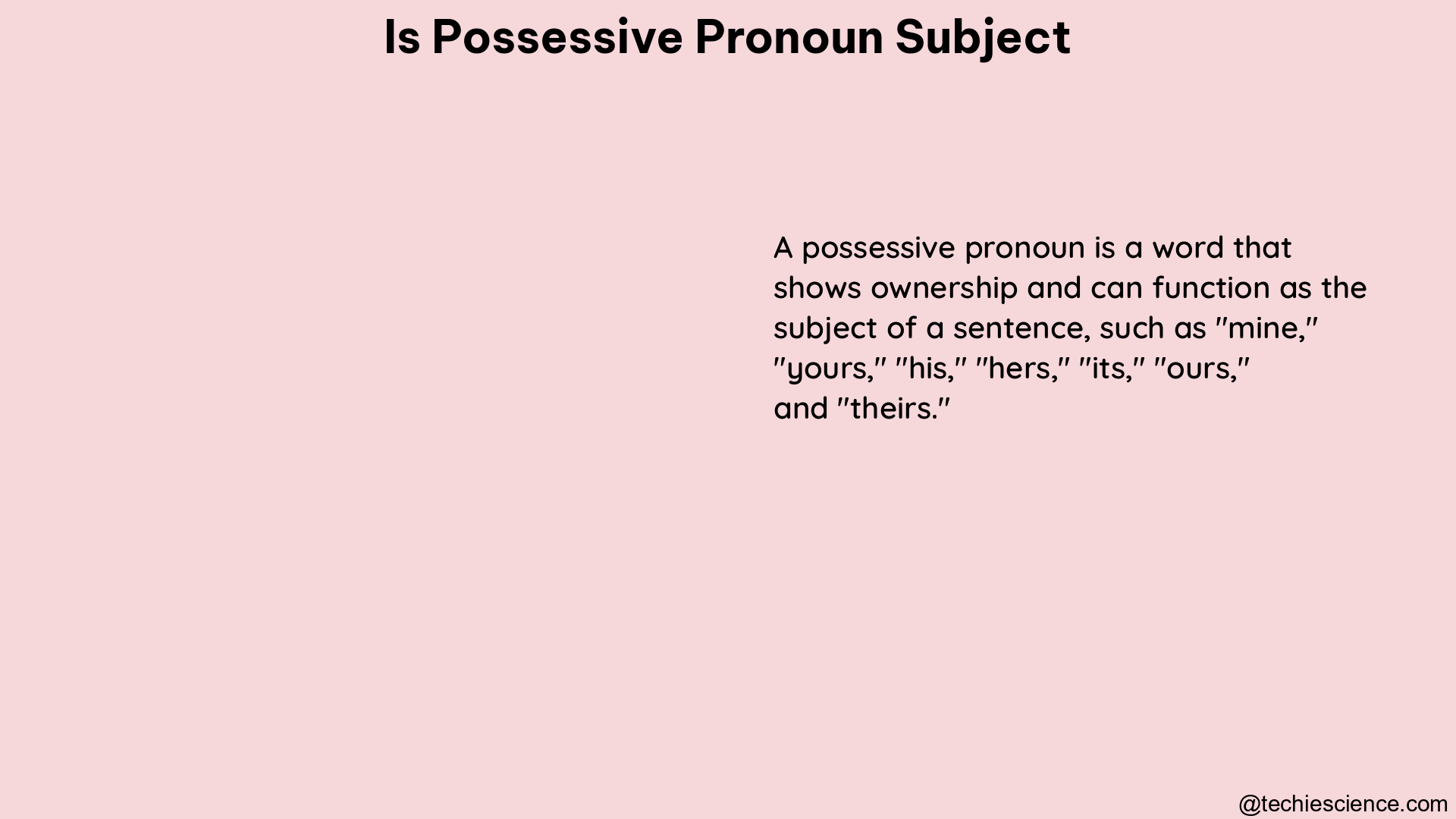Possessive pronouns are a crucial part of the English language, allowing us to express ownership and belonging in a concise and efficient manner. However, it is important to understand the grammatical role of possessive pronouns and how they differ from subjects within a sentence. In this comprehensive guide, we will delve into the intricacies of possessive pronouns, their definition, function, and their relationship to subjects, providing you with a thorough understanding of this essential linguistic concept.
Definition and Types of Possessive Pronouns
Possessive pronouns are a class of pronouns that indicate ownership or possession. They replace nouns to show who or what something belongs to. The most common possessive pronouns in English are:
- Personal Possessive Pronouns:
- Mine
- Yours
- His
- Hers
- Its
- Ours
-
Theirs
-
Reflexive Possessive Pronouns:
- My own
- Your own
- His own
- Her own
- Its own
- Our own
- Their own
These pronouns are used to replace nouns in sentences, making statements about ownership more concise and clear. For example:
- “This book is mine.” (Here, “mine” indicates that the speaker owns the book.)
- “That car is hers.” (Here, “hers” indicates that the car belongs to her.)
Grammatical Role of Possessive Pronouns

Possessive pronouns do not typically function as subjects in a sentence. Instead, they usually serve as:
1. Objects
Possessive pronouns can act as objects, receiving the action of the verb and indicating what is possessed.
Example:
– “The book is mine.” (Here, “mine” is the object, indicating what is possessed.)
2. Complements
Possessive pronouns can also serve as complements, providing additional information about the subject, often indicating possession.
Example:
– “The car is hers.” (Here, “hers” is a complement, providing more information about the car.)
It is important to note that possessive pronouns are not the same as possessive adjectives, which are used to modify nouns and indicate ownership. Possessive adjectives, such as “my,” “your,” “his,” “her,” “its,” “our,” and “their,” are used before nouns, while possessive pronouns replace nouns.
Possessive Pronouns vs. Subjects
To further clarify the distinction between possessive pronouns and subjects, let’s examine some examples:
- Possessive Pronoun as Object or Complement:
- “The book is mine.” (Here, “mine” is the possessive pronoun, acting as the object.)
-
“The car is hers.” (Here, “hers” is the possessive pronoun, acting as a complement.)
-
Subject vs. Possessive Pronoun:
- “She is the owner of the house.” (Here, “she” is the subject, and “the owner of the house” is the predicate nominative.)
- “The house is hers.” (Here, “the house” is the subject, and “hers” is the possessive pronoun indicating possession.)
In the first set of examples, the possessive pronouns “mine” and “hers” are not subjects but rather objects or complements that indicate ownership or possession. In the second set of examples, the subjects are “she” and “the house,” while the possessive pronouns “hers” provide additional information about the ownership or possession.
Identifying Possessive Pronouns in Sentences
To help you identify possessive pronouns in sentences, consider the following guidelines:
-
Look for Pronouns: Possessive pronouns are a type of pronoun, so you should first identify any pronouns in the sentence.
-
Determine if the Pronoun Indicates Possession: If the pronoun is used to indicate ownership or belonging, it is likely a possessive pronoun.
-
Check the Grammatical Role: As discussed earlier, possessive pronouns typically function as objects or complements, not as subjects.
Here are some examples to help you practice:
| Sentence | Possessive Pronoun | Grammatical Role |
|---|---|---|
| “This book is mine.” | “mine” | Object |
| “The car is hers.” | “hers” | Complement |
| “She is the owner of the house.” | “her” (possessive adjective) | N/A (not a possessive pronoun) |
| “The house is theirs.” | “theirs” | Complement |
| “I found your keys on the table.” | “your” (possessive adjective) | N/A (not a possessive pronoun) |
By following these guidelines, you can confidently identify possessive pronouns and understand their role within a sentence, distinguishing them from subjects and other grammatical elements.
Conclusion
In summary, possessive pronouns are a crucial part of the English language, allowing us to express ownership and belonging in a concise and efficient manner. However, it is important to understand that possessive pronouns do not typically function as subjects in a sentence. Instead, they usually serve as objects or complements, indicating what is possessed or providing additional information about the subject.
By mastering the definition, types, and grammatical role of possessive pronouns, you can enhance your understanding of English grammar and improve your ability to communicate effectively. Remember, the key to identifying possessive pronouns is to look for pronouns that indicate ownership or possession, and then determine their grammatical function within the sentence.
Reference:
- Possessive Pronouns: Definition, Types, and Examples
- Possessive Pronouns vs. Possessive Adjectives
- Possessive Pronouns: Definition, Examples, and Exercises
Hi… I am Sowndharya Jagadeeswaran, a university rank holder in M.A. English Literature. I have also done my master’s in Business Administration. Inquisitive as I am, my interest in action-oriented research helped me publish research papers in reputed journals. Now, as a career, I am an instructor where I teach young and adorable students the intricate technicalities of Public Speaking and Creative Writing. I also enjoy writing articles on topics I specialize and research in.
You can connect with me through LinkedIn.-